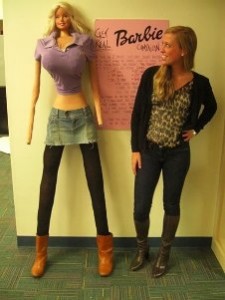 Galia Slayen has gotten a lot of attention for building a life-sized Barbie to help bring awareness for National Eating Disorder Awareness Week.
Galia Slayen has gotten a lot of attention for building a life-sized Barbie to help bring awareness for National Eating Disorder Awareness Week.
Her Barbie certainly looks like an exaggerated ideal, much like other cartoons and toys. Unfortunately, Galia wasn’t able to create a proportional head and used a toy to top off her life-sized Barbie, but the other proportions are dead on for what Barbie would look like if she were a real woman. While it is certainly clear that Barbie’s waistline is unrealistically thin, I would hate to see what any of Disney’s princesses would like compared to a real human body.
Barbie is just one more example of how the media favors an unrealistic ideal when it comes to body shapes and sizes. Let’s not forget He-man and G.I. Joe when we consider what toys suggest to children. There are toys and cartoons and then there are airbrushed images in magazines and movie stars. Call it unrealistic or idealism, we are surrounded from early childhood. The problem comes when we start to expect this impossibly unrealistic exaggeration from ourselves as real people. That is when we can start to see unhealthy attempts to achieve such impossible ideals and the development of eating disorders.
When our children watch cartoons and play with toys like Barbie, it is important that we also expose them to realistic, healthy images. It is important that we check our own attitudes about body image and the worth of a person based on more than dress size. While the toys we play with impact our childhood, ultimately it is a parent who has the greatest influence on a child and his or her self-esteem.
